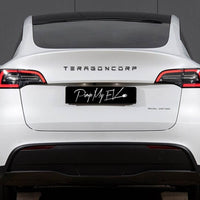What is Tesla's Regenerative Braking?
Tesla cars have a function called "regenerative braking" a feature that uses electric motors to slow down the car instead of the friction brakes. This helps save energy and makes the battery last longer.
When you take your foot off the speed brake pedal, the electric motors turn on. They turn the car's motion into electricity, the surplus power which is then saved in the battery. This makes the electric vehicle go slower and helps the battery charge at the same time.
Why Does Regenerative Braking Not Work Sometimes?
There are a few reasons why regenerative braking may not work in your Tesla. Here are some of the most common reasons:
- The battery is cold. Regenerative braking works best when the battery is warm. If the battery is cold, the car will use the friction brakes more often.
- The battery is fully charged. When the battery is fully charged, there is no place for the energy from regenerative braking to go. This is why you may see a dotted line in the car's power meter when the battery is full.
- The car is in Hold mode. Hold mode disables regenerative braking. This mode is useful for driving downhill, as it prevents the car from accelerating when you take your foot off the accelerator.
- The car has a software update pending. Sometimes, software updates can affect the performance of regenerative braking. If you have a software update pending, install it to see if it resolves the issue.
- The car's braking system is malfunctioning. This is a rare occurrence, but it is possible that the braking system in your Tesla is malfunctioning. If you suspect this is the case, you should take your car to a Tesla service center for diagnosis.
- The car's tires are worn or damaged. Worn or damaged tires can affect the performance of regenerative braking. If you suspect this is the case, you should have your tires checked by a professional.
Resolving Regenerative Braking Problems in Your Tesla
Here, we will first explain all of the potential reasons for the problems Tesla owners are experiencing with the regenerative braking system, and then we will provide you with the remedies to those problems. Let's just jump right in.
Cause #1: Extreme Cold Weather
A lot of the time, the Tesla's regenerative braking can get limited by cold weather or snowy or icy driving conditions too, which can make it act in strange ways. Most of the time, this happens when the temperature is below 40–50°F (4.44–10°C) and is different when the temperature rises.

When this happens, the car starts to heat up the battery to protect it. During this process, the visible dots on the battery temperature power meter are blocked off.
This thing slowed down the vehicle with regenerative brakes, which made it not work right. Tesla owners might need to warm up the car before they use it to fix it.
In snowy or icy conditions, it's crucial to ensure that your brake pads are well-maintained to guarantee safe stopping, especially when regenerative braking might be affected.
How to Solve?
- First, go to Climate Controls and turn on the button for Preconditioning. Then, set the time by clicking on Schedule. This will take about 30–45 minutes to get your car's battery ready. Learn how to prepare a Tesla battery for more information.
- Then, open up the Tesla app on your phone. After that, go to the Climate menu and raise the temperature to warm up the house. This also helps heat up the cell.
- Lastly, open the Tesla app and click on Climate, then Defrost Car. That will start to warm up your car's battery.
Cause #2: Deceleration Reduction
If you use Tesla regenerative braking more than you're allowed to when it's limited, you might get the "Tesla regenerative braking temporarily reduced" error message. It normally happens with winter tires when the speed of slowing down slows down less in the winter.

Check the "P R N D" spot on the left side of the power meter to see if it works. From this area, the D part shows how the acceleration is released, which causes the motor and the regen brakes to slow down.
Changing the settings in the Tesla's regenerative braking options is an easy way to fix the problem.
How to Solve?
- Start by clicking on Controls, then Pedals & Steering, and then look for the part called "Regenerative Braking."
- Next, find the choice called "Apply Brake When Regenerative Braking is Limited" and turn it on. Now, go to the power meter to see if the regenerative braking works.
Cause #3: Upcoming Update Issue
Sometimes, the car's regen is limited mistakes are caused by the newest software. Changes to the system are usually to blame.
You'll need to download and run the Tesla software update on the monitor and app to fix the problem.
How to Solve?
- Via Touchscreen – Go to Controls > Software and locate the software option. Then, update the software available.
- Via Tesla App – Open the app and hit on Software Update > Yes or Install Now option. Wait for it to update and do not open any doors, windows, and so on.
Additional Tips:
- To extend the range of your Tesla, you can use regenerative braking as much as possible. When you lift your foot off the accelerator pedal, the car will slow down using regenerative braking. This will help to recharge the battery and extend the range of your car.
- You can also adjust the level of regenerative braking in your Tesla. There are two settings: Standard and Low. Standard provides the most regenerative braking, while Low provides less regenerative braking. You can adjust the setting in the Tesla app.
- If you are driving in icy weather, you may want to disable regenerative braking. This is because regenerative braking can create resistance that can make it difficult to control the car in icy conditions.
Does Regenerative Braking Activate Your Brake Lights?
Yes, Tesla's regenerative braking activates your brake lights. This is in normal driving and is because regenerative braking slows the car down, and the brake lights are designed to warn other drivers that you are slowing down.
How To Prevent a “Regenerative Braking Not Working” Issue?
Here are some ways to avoid "regenerative braking not working" problems:
- Smoothly speed up and slow down. The regenerative braking system can be put under stress when the car speeds up or slows down quickly.
- Don't drive when it's cold. When the battery is warm, stopping that charges the battery works best.
- Make sure the battery is full. A fully charged battery will work better and let you use regenerative braking more often.
- Software should be updated often. Tesla usually puts out software changes that make the regenerative braking system work better.
Can You Adjust Regen Braking On Tesla?
Yes, you can change how much regenerative braking a Tesla car has. You can choose between Standard and Low. Standard is the usual level, and it gives you the most regenerative braking. On low, the regenerative braking is less.
Follow these steps to change the setting for regenerative braking:
- Open the app for Tesla.
- Tap the car picture.
- Select Settings.
- Select Controls.
- Touch the Pedal and Steering.
- Move the button for Regen Braking to the setting you want.
- Software Update Screen
Regenerative Braking Limited or Reduced
In Tesla cars, the Tesla regenerative braking system can be restricted or turned off in certain situations, such as:
- If the battery is cold
- When the battery's charge is full
- When the car is in the Hold mode,
- When the car goes downhill
- When the car's software is being updated
- If the regenerative braking system is restricted or turned down, the touchscreen monitor will tell you.

The Investigation and Tesla's Leading Role in Resolving Regenerative Braking
The National Highway Traffic Safety Administration (NHTSA) started looking into Tesla cars in 2021 after people said they stopped suddenly. Even though the probe is still going on, Tesla has already taken steps to fix the problem.
In 2022, Tesla put out a software update that made the regenerative braking system work better. The update also added a new option that lets drivers change how much regenerative braking they want their vehicles to use.
Tesla cares about safety and works hard to make sure that its cars have the most up-to-date safety measures.
 :
:  :
: 



















